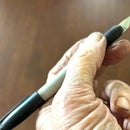Introduction: Fix Harbor Freight Garden Lights
My wife received a set of three garden lights sold by Harbor Freight and made to look like insects when lit at night. These are not expensive and are attractive, but quit working easily. This Instructable will show how to keep them working, and to restore any you may have put aside because they quit working.
Materials
- Solder
- Stranded copper wire
Tools
- Small Phillips screwdriver
- Knife
- Soldering gun
- Drill and 3/16 inch bit
- Pencil eraser
Step 1: Open the Battery Case
Look at the bottom of the battery case. (The top surface is the solar cell for recharging.) The two yellow arrows indicate the location of the Phillips screws to be removed.
See the text box around the slide switch. It mentions rust stains that form when water from rain or sprinkler systems gets into the battery case and nearly fills it. This water is the reason why these lights stop working.
Step 2: Weep Holes
A reviewer of these lights at the Harbor Freight web site drilled weep holes in the bottom of the battery case so any water that gets in can get out before it does any real damage. The end of the battery case where the yellow arrows are tends to be a little lower than the rest of the battery case when the lights are in operation. It is the front end farthest away from the metal pole on which the battery case is mounted. I drilled two holes 3/16 inch in diameter, one on each half of the battery case to make it easier for any water present to drain out before building up too much.
The blue circle shows some water still in the battery case, even with the weep holes.
The left half of the photo shows the rechargeable battery and the small circuit board. Check the leads on components like capacitors. I found an accumulation of "dirt" from rusting between the two leads of a small electrolytic capacitor next to the slide switch. Use a knife blade or a toothpick to clean up any debris like that.
Step 3: Loosen the Circuit Board From Its Mounts
Notice how rusty the slide switch appears. Water had gotten inside the slide switch on all three light units in my wife's set. There was rust inside. I decided I would need to make a shunt across this single pole switch to restore full function.
The circuit board rests on top of two plastic posts. Like a rivet, the top of the pin was flattened at the factory with heat. Lightly pry upward with a knife to release the circuit board. The support at the right of the circuit board releases without prying. Once the left side has been lifted, just slide the board to the left and raise it when it is free.
When handling the circuit board, be careful not to break any wires from their solder joints. Be gentle. As a precaution, you might take a photo of the bottom of the circuit board before further handling. That could help to know where a wire was before it broke away.
Step 4: Solder a Shunt Across the Switch
No matter how much I worked with the slide switch, it was not dependable. Sometimes it simply did not close to make a circuit. Sometimes it closed to make a circuit, but the rust caused extra resistance and the LED on the light did not glow with its full brightness.
The two yellow arrows indicate the circuit traces normally bridged by the switch. I stripped about 1/2 inch at the end of some small gauge copper wire about the size of speaker wire. I tinned it with solder. Then I soldered the end to one trace. Next I soldered the tinned wire to the contact point on the other trace. Then I clipped the wire so only the shunt remained. You can see my shunt just to the right of the tips of the yellow arrows.
The slide switch has two settings: "Auto" and "Off." I decided I would never need the switch and permanently shunting it seemed a very logical option.
Step 5: One More Thing
If the battery case filled with water in the past, and you found rust, chances are there is also rust on the tip of the battery and on the battery holder. Clean the battery holder contacts and the ends of the battery with a pencil eraser.
Step 6: Assemble and Test
Carefully put the two halves of the battery case back together and secure it with its two screws. Do not forget to fit the pivot holes around the mounting posts. Also, make certain the wire from the battery case to the metal pole is in the opening made for it. If the case does not close tightly as it should, the battery can move a little and the electrical contact with the battery holder is lost.
Assuming the battery is not fully discharged, test the light by covering the solar cell with your hand. The clear plastic insect should light in different colors as the LED changes from one color to another.





